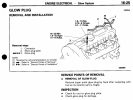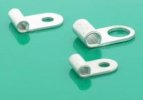connorwhite.online
Active Member
I peeled off my glow plug plate (the sheet metal connecting all 4 plugs electrically) to clean off what I thought was crusted oil, and found that it was actually corrosion (probably aluminum oxide). However I haven't heard the term "rust" applied to aluminum, even though aluminum does in fact oxidize. I consulted the manual and found that an inspection point was to check for rust on the glow plug plate. The plate was so light, I can't imagine it's anything other than aluminum or some electrically conductive alloy. Does anyone know for certain? I'm quite novice with metallurgy.
I ask because I'm thinking of having copper sheet cut to the same silhouette in hopes that the higher electrical conductivity of copper (about twice as much) would be a strong upgrade over the stock plate.
I ask because I'm thinking of having copper sheet cut to the same silhouette in hopes that the higher electrical conductivity of copper (about twice as much) would be a strong upgrade over the stock plate.
Attachments
Last edited:


